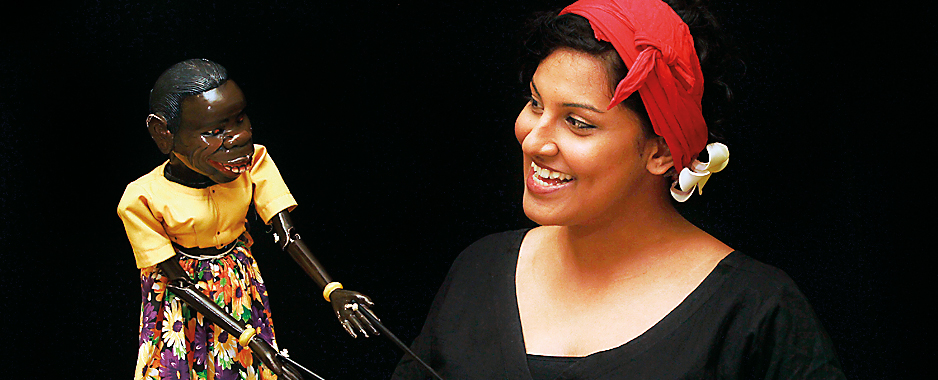Getting to know all about them
Sulochana Dissanayake lives in a crowded house. There’s an elephant on her porch and the decapitated head of a giant on her dining room table. There’s a herd of animals – a zebra, chimpanzee, a ‘gangster’ penguin and another, smaller elephant – and a host of characters right out of Sri Lankan folklore (old Mahadanamutta says hello). Many are hard to recognise because their clothes are turned inside out and pulled up over their faces (to keep those inscrutable expressions from chipping) but their puppeteer knows who they are.

Since 2009, when she graduated from Bates College in the U.S.A with a B.A in Economics and Theatre, Sulochana has begun collecting puppets in earnest. She has just over 70 pieces – including the two giant puppets, one of which is lit like a lantern and needs two people inside it to bring it alive. Her little muppets – the soft puppets with expressive mouths – are a favourite with the children, but the exquisitely crafted wooden puppets from Indonesia are what impress the adults.
The layers of detail – from the carving of every single strand of hair and wrinkle to the addition of eyelashes – make these handmade puppets works of art.
Sulochana’s audiences seem as excited to encounter the puppets as she is. “In the first instant that they see the puppet they are absolutely bowled over by their fascination,” Sulochana says, explaining that this is true even if the puppet is only a few centimetres tall.

Wonder or laughter are both equally potent tools in that they tear down defences and make otherwise unthinkable conversations possible. “How can you get angry with a puppet?” asks Sulochana. The answer is of course, that you can’t. “Puppets can argue about sex, HIV/AIDS and war and get away with it. They say everything that is in our subconscious but they say it in a way that is not offensive.” Of course, Sulochana must still put a great deal of thought into what she wants to say – only not too much.
“I thought the puppeteers in Indonesia were crazy when they told me they go into a trance,” she remembers. “They’re an extremely religious community and they say that it is God who speaks through them.” After having performed and designed a few shows like ‘Ruukada Golek’ for Sri Lankan audiences Sulochana knows that it does take a sort of letting go to be able to perform effectively. For her the ‘trance’ is actually an intense concentration that allows her to keep tabs on her audience during her interactive shows while improvising dialogue, singing and animating a puppet in each hand (it helps that she’s ambidextrous).
“There’s not a moment you can switch off, you have to be entirely focused on what you’re doing,” she says, explaining that the mirror is her best friend during the hours spent rehearsing. She has to watch herself – if she’s not careful, one of her puppets will “die,” i.e go limp onstage.
Her first encounter with a new puppet is quite literally character building – they must decide together who this puppet will be and then convey that to an audience. The secret to making it come alive lies in conveying the simplest of movements. The moment a puppet appears in the frame he or she has to behave as a human would. “If you entered into a new room what would you do? The first thing you would do is breathe and then take a look around,” says Sulochana, explaining that the illusion of the former can be accomplished by simply raising and dropping the shoulders ever so lightly.

In the service of her puppets, she has become a connoisseur of accents and says she’s always filing away new ones in her memory. Having undergone voice training as a young person, Sulochana loves playing around with the voices for each new puppet – will it be authoritative or timid? High pitched or nasal? Will he or she be a smoker? Sulochana has to figure it out.
For all the effort she puts into a performance, Sulochana knows that for a maestro like Kalubushana Ganwari Premin, she’ll be an amateur until she can not only perform with a puppet but make her own as well.
For the upcoming Colombo Dance Platform this November, they spent hours filming him in action from backstage. She’s excited about the images they have of puppeteer and puppet dancing together – a technique that allows traditional Sri Lankan puppeteers to manipulate their heavy puppets. “It’s a fascinating process to watch,” she says, explaining that “He’s basically doing the exact same dance that the puppet is doing.”
It’s also exhausting and leaves him drenched in sweat.Luckily, Sulochana’s ambition isn’t to become a master puppeteer, instead it is to explore new ways of communicating her ideas and her art. For her, introducing a puppet into the mix is simply the best way of beginning that conversation.
Follow @timesonlinelk
comments powered by Disqus


























